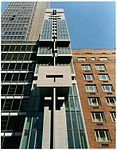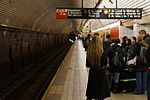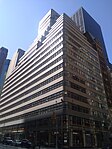Cartier Building

The Cartier Building, also 653 Fifth Avenue, is a commercial building on the southeast corner of 52nd Street and Fifth Avenue in the Midtown Manhattan neighborhood of New York City. The building serves as the flagship store of Cartier in New York City. It consists of two conjoined residences completed in 1905: the Morton F. Plant residence at 651–653 Fifth Avenue, designed by Robert W. Gibson, and the Edward Holbrook residence at 4 East 52nd Street, designed by C. P. H. Gilbert. The Plant House was designed in the Neo-Renaissance style and has facades on both 52nd Street and Fifth Avenue. The 52nd Street facade of the house contains an ornate pavilion, and both facades have an attic hidden inside a frieze. The Edward Holbrook House was also designed in a neoclassical style but has a mansard roof. Both houses are five stories tall and are connected internally. The Cartier store takes up all of the stories inside the building. The southeast corner of Fifth Avenue and 52nd Street was planned as a hotel in the early 1900s after the Roman Catholic Asylum vacated the site. After the Vanderbilts blocked the development of the hotel, the northern portion became the Morton F. Plant House, while the southern portion of the site was developed as the Marble Twins at 645 and 647 Fifth Avenue. In the late 1910s, Plant sold his house to Cartier. The Holbrook House was occupied by a variety of tenants until 1927, after which it was purchased by 653 Fifth Avenue's owners and used by various organizations and firms. The New York City Landmarks Preservation Commission designated the Cartier Building as a city landmark in 1970, and it was added to the National Register of Historic Places in 1983 along with 647 Fifth Avenue.
Excerpt from the Wikipedia article Cartier Building (License: CC BY-SA 3.0, Authors, Images).Cartier Building
5th Avenue, New York Manhattan
Geographical coordinates (GPS) Address Nearby Places Show on map
Geographical coordinates (GPS)
| Latitude | Longitude |
|---|---|
| N 40.7595 ° | E -73.976 ° |
Address
5th Avenue 647
10022 New York, Manhattan
New York, United States
Open on Google Maps








